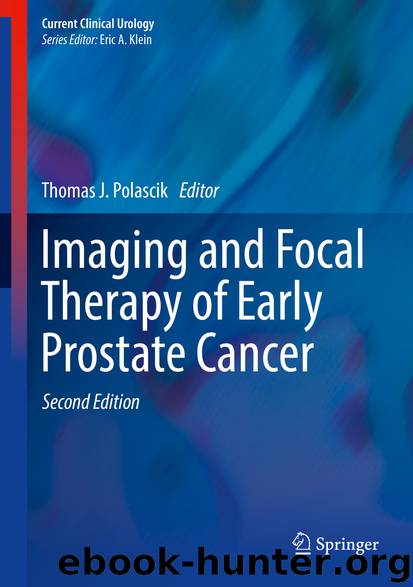Imaging and Focal Therapy of Early Prostate Cancer by Thomas J. Polascik

Author:Thomas J. Polascik
Language: eng
Format: epub
Publisher: Springer International Publishing, Cham
Image-Based Tracking
The Urostation platform (Koelis, Grenoble, France), widely utilized across clinical centers in Europe, is an interesting platform in that tracking of the TRUS probe and needles is conducted with TRUS-TRUS registration. Thus, additional hardware such as an electromagnetic field generator or robotic arms is not necessary. The process begins with acquisition of prostate MRI as in other fusion platforms. At time of biopsy procedure, a 3D panorama TRUS volume is obtained via sweep of the prostate, and this model is fused to pre-procedural MRI data using elastic registration. Then, after each biopsy core is taken, a 3D TRUS image is acquired with the needle in place and registered to the original sweep TRUS volume to confirm proper needle placement. Similar to UroNav, this platform is advantageous as the biopsies are performed utilizing a standard freehand approach. However, one important drawback is that needles must be held in place without movement for 3–5 s to allow for 3D TRUS acquisition in order to acquire an accurate needle location. As technology improves, real-time 3D US image acquisition may make the process seamless.
Initial studies with phantom models conducted by Ukimura et al. at the University of Southern California (USC) in Los Angeles, California, USA , demonstrated an accuracy of 84 % (24/27 lesions hit) with this platform and a mean procedural targeting error of 2.09 ± 1.28 mm [40]. In a study of 80 patients with 115 MRI suspicious lesions, the hit rate for the Urostation platform was 97 % (112/115 lesions with confirmed biopsy inside target), and 60/115 (52 %) targets were positive for cancer [60]. Mozer et al., in a prospective study utilizing the Urostation platform in 152 biopsy-naïve men, found that the proportion of positive cores and proportion of men with clinically significant prostate cancer were significantly higher with the targeted-core protocol relative to a systematic 12-core protocol (p < 0.001 and p = 0.03, respectively). Therefore, initial work with this platform seems promising.
Download
This site does not store any files on its server. We only index and link to content provided by other sites. Please contact the content providers to delete copyright contents if any and email us, we'll remove relevant links or contents immediately.
| Automotive | Engineering |
| Transportation |
Whiskies Galore by Ian Buxton(41540)
Introduction to Aircraft Design (Cambridge Aerospace Series) by John P. Fielding(32893)
Small Unmanned Fixed-wing Aircraft Design by Andrew J. Keane Andras Sobester James P. Scanlan & András Sóbester & James P. Scanlan(32580)
Craft Beer for the Homebrewer by Michael Agnew(17938)
Turbulence by E. J. Noyes(7717)
The Complete Stick Figure Physics Tutorials by Allen Sarah(7148)
Kaplan MCAT General Chemistry Review by Kaplan(6605)
The Thirst by Nesbo Jo(6447)
Bad Blood by John Carreyrou(6284)
Modelling of Convective Heat and Mass Transfer in Rotating Flows by Igor V. Shevchuk(6230)
Learning SQL by Alan Beaulieu(6043)
Weapons of Math Destruction by Cathy O'Neil(5845)
Man-made Catastrophes and Risk Information Concealment by Dmitry Chernov & Didier Sornette(5670)
Digital Minimalism by Cal Newport;(5397)
Life 3.0: Being Human in the Age of Artificial Intelligence by Tegmark Max(5198)
iGen by Jean M. Twenge(5166)
Secrets of Antigravity Propulsion: Tesla, UFOs, and Classified Aerospace Technology by Ph.D. Paul A. Laviolette(5002)
Design of Trajectory Optimization Approach for Space Maneuver Vehicle Skip Entry Problems by Runqi Chai & Al Savvaris & Antonios Tsourdos & Senchun Chai(4848)
Electronic Devices & Circuits by Jacob Millman & Christos C. Halkias(4754)
